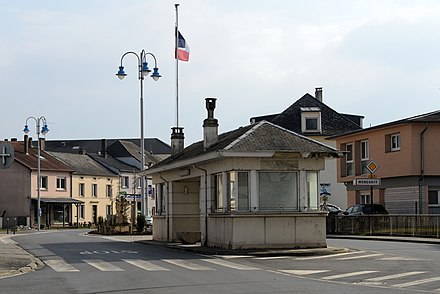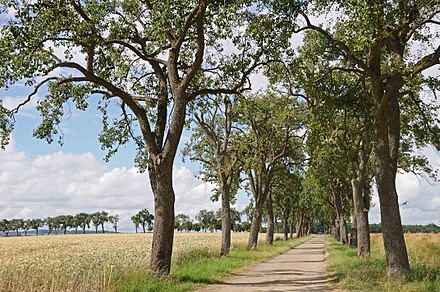Mondorf-les-Bains - municipality of Luxembourg
 Mondorf-les-Bains or Mondorf for short, is a spa town in southeastern Luxembourg. Its facilities are among the most modern in Europe. The waters are particularly suitable for the treatment of liver, gastric and respiratory ailments. It was home to 5,100 people in 2018.
Mondorf-les-Bains or Mondorf for short, is a spa town in southeastern Luxembourg. Its facilities are among the most modern in Europe. The waters are particularly suitable for the treatment of liver, gastric and respiratory ailments. It was home to 5,100 people in 2018.
Understand
 Mondorf was first inhabited by the Celts. The Romans, which arrived around 65 BC, built a fortification to protect the road from Metz to Trier. In the ninth century, the village was donated to the Echternach Abbey, that named it Muomendorph, which, over time, changed in to Mondorf. Mondorf was frequently burnt down and rebuilt. The Saint Michael's Church, for example. It was rebuilt on four occasions, with the last rebuilding being finished in 1764.
Mondorf was first inhabited by the Celts. The Romans, which arrived around 65 BC, built a fortification to protect the road from Metz to Trier. In the ninth century, the village was donated to the Echternach Abbey, that named it Muomendorph, which, over time, changed in to Mondorf. Mondorf was frequently burnt down and rebuilt. The Saint Michael's Church, for example. It was rebuilt on four occasions, with the last rebuilding being finished in 1764.
In the 1840s, thermal waters were uncovered when drilling for salt, which had become highly taxed under the then Dutch rule. Despite their mineral properties, the waters were not suitable for any usage, due to their brown colour caused by the rocks, rich of iron, that they were located in. Nevertheless, the Société des Bains de Mondorf (Association of the Baths of Mondorf) was set up. Immediately an architect was issued to build the thermal establishment, which was finished in June 1847. As a result of the spa's success, the village started prospering from rich French guests that came and stayed in the luxurious hotels. This tourism, however, stopped in 1871, when the Germans occupied parts of France.
Though the city implemented its number one feature, the spa, in its name in late August 1878, the spa kept on declining. This decline wouldn't stop until the state bought the facilities in 1886. Minister of State Paul Eyschen managed to revive profits by encouraging Belgians to visit. The spa facilities were expanded with a pavilion, banqueting hall, reading room, Orangerie and the first ever indoor swimming pool of Luxembourg.
After the First World War, a new spa centre was designed and was later opened in 1926. During the 1930s, the hotels by the spas weren't used by visitors, but instead by people fleeing from the Nazi German uprising. During the Second World War war, the spas were renamed Staatsbad-Mondorf, and was a place where rich Nazis could relax. After the war, in the second half of the 20th century, the spa continued to prosper with the construction of a new outdoor swimming pool (1953), new thermal centre (1988) and the new Casino 2000, opened in 1983.
Get in

By car
When travelling from Luxembourg City, turn onto the A3 heading for Thionville (France). At the Croix de Bettembourg interchange, turn onto the A13 heading for Saarbrücken and Remich. Leave this highway at exit 12, and go right in the direction of Mondorf(-les-Bains).
When coming from the east (i.e. Germany), use the A13, or the German Autobahn 8, which will turn into the A13 at the border crossing nearby Schengen. Exit the A13 at exit 12 and turn left in the direction of Mondorf(-les-Bains).
By public transit
Mondorf is not on any train route, though it is well-connected via bus services. The main bus station for the town, Mondorf Christophorus, 49.50458°, 6.27467°. , connects to the line between Luxembourg City and Remich (lines 175 and 177), as well as with Bettembourg (line 304). From Luxembourg City travel by plane and train is possible, and from Bettembourg travel by train is possible.
Get around
Mondorf is rather small and can be travelled by foot.
See
- Aviation Museum Luxembourg (In the Domaine Thermal's public park), 52 Avenue des Bains, 49.5011°, 6.2825°, +352 23 66 66 66. 2016-08-19
Do

- Mondorf Domaine Thermal, 52 Avenue des Bains (At the end of Avenue des Bains), 49.50330°, 6.28432°. Thermal source waters at 36 °Celsius, mudbaths, fitness and saunas. 2016-08-19
- Casino 2000, Rue Flammang, 49.5076°, 6.2793°, +352 23 61 11 1. 10:00-04:00. 2016-08-19
Buy
Eat
- Bel Fontaine, 17 Avenue des Bains, 49.50317°, 6.28035°, +352 23 66 83 56. 11:30-14:00, 18:00-23:00. 2016-08-19
- Hôtel Restaurant Pizzeria Dolce Vita, 4 Avenue Dr. Klein, 49.50464°, 6.27931°, +352 23 66 80 73. 2016-08-19
- Brasserie Chalet am Brill, Avenue Marie-Adélaïde, 49.5062°, 6.2836°, +352 23 666-545, reservation@mondorf.lu. 2016-08-19
- le Manège, Rue Flammang, 49.5072°, 6.2816°, +352 23 61 14 11. 19:00 - 00:00 (-01:00 on Friday and Saturday). 2017-06-16
- Brasserie Bistro Maus Kätti, Avenue des Bains, +352 23 666-666, reservation@mondorf.lu. 2017-12-18
- Restaurant De Jangeli, Impasse Emile Didderich, +352 23 666-666, reservation@mondorf.lu. 2017-12-18
Drink
- Café Lorrain, 6 Avenue François Clément, Mondorf-les-Bains, 49.50483°, 6.27248°, +352 23 66 81 31. 08:00-23:00, closed on Tuesdays. 2017-06-16
Sleep
- Mondorf Parc Hôtel, Avenue Dr Ernest Feltgen, 49.50250°, 6.28239°, +352 23 66 66 66. 4-star hotel €205 2016-08-19
- Villa Welcome, 52 Avenue des Bains, 49.5031°, 6.2839°, +352 23 66 66 66. €132 2017-06-16
- Hôtel-Residence Am Klouschter, 8 Avenue Marie-Adélaïde, 49.5052°, 6.2853°, +352 27 99 10 00. 2017-06-16
Connect
- Mondorf-les-Bains Tourist Information, B.P. 2, 26-28 Avenue des Bains, +352 23 66 75 75. 2016-08-19
Go next
- Explore the rest of the Grevenmacher district with cities such as Echternach, Grevenmacher, Remich and Schengen.
- Discover the breathtaking nature of the Mullerthal region.
- France is just across the border, Thionville and Metz are the closest cities.
- The Land of the Red Rocks, located not far east and reached easily by bus is filled to the brim with industrial heritage.
Mondorf-les-Bains
mondorf-les-bains.luMondorf-les-Bains
2nd-order administrative division
Remich
Primary administrative division